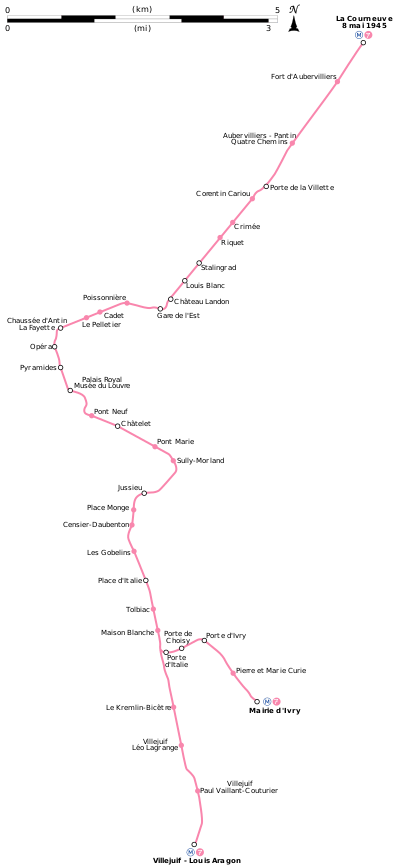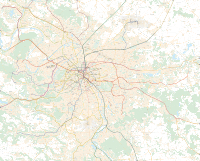Paris Métro Line 7
Paris Métro Line 7 is one of sixteen lines of the Paris Métro system. Crossing the capital from its north-eastern to south-eastern sections via a moderately curved path, it links La Courneuve – 8 Mai 1945 in the north with Mairie d'Ivry and Villejuif – Louis Aragon in the south, while passing through important parts of central Paris.
Line 7 began operating in 1910 and, along with Line 13, is one of only two Métro lines that has a branch. Originally located in the northeast and splitting at Louis Blanc, it was transferred in 1967 to what is now Line 7bis. In 1982, a new branch was added in the southeast to Mairie d'Ivry, branching off at Maison Blanche. Line 7 has only steel rails.
At 18.6 km (12 mi), Line 7 is one of the longest in the Paris Métro network. In addition, it contains the most stations as well as being the third most-used line of the Métro, with 120.7 million riders in 2004.[1]
History
Chronology
- 5 November 1910: Line 7 was opened linking Opéra to Porte de la Villette.
- 18 January 1911: A new branch was opened from Louis Blanc to Pré-Saint-Gervais.
- 1 July 1916: The line was extended in the south from Opéra to Palais Royal.
- 16 April 1926: The line was extended from Palais Royal to Pont Marie.
- 15 February 1930: While a tunnel was being built on line 7 to cross the River Seine, a new section between Place Monge and Place d'Italie was opened and temporarily operated as part of Line 10.
- 3 June 1930: The line was extended from Pont Marie to Pont de Sully.
- 7 March 1930: That section temporarily operating as part of Line 10 was extended from Place d'Italie to Porte de Choisy.
- 26 April 1931: The section between Pont de Sully and Place Monge was opened. The section between Place Monge and Porte de Choisy was transferred to Line 7 and it was extended to Porte d'Ivry simultaneously.
- 1 May 1946: The line was extended from Porte d'Ivry to Mairie d'Ivry.
- 1967: Because of a lack of traffic, the northern branch of the line 7 between Louis Blanc and Pré-Saint-Gervais became a new independent line known as Line 7bis.
- 4 October 1979: The line was extended to the north from Porte de la Villette to Fort d'Aubervilliers.
- 10 December 1982: A new branch was opened to the south from Maison Blanche to Le Kremlin-Bicêtre.
- 28 February 1985 : The line was extended from Le Kremlin-Bicêtre to Villejuif Louis Aragon.
- 6 May 1987: The line was extended from Fort d'Aubervilliers to La Courneuve – 8 mai 1945.
Future
- An extension of Line 7 from La Courneuve to Le Bourget may be considered in the future.
- The southern fork of the line from Maison Blanche to Villejuif – Louis Aragon may be taken over by line 14 in the future.
- Line 7bis, the branch line of line 7, may be merged with line 3bis to form a new line, with its western terminus at Château-Landon on line 7.
Route and stations

Route
Line 7 runs for 18.6 km (12 mi) completely underground, stopping at 38 stations. Southbound trains terminate alternately at Villejuif - Louis Aragon and Mairie d'Ivry, diverging at Maison Blanche. Late at night, through trains only operate to Mairie d'Ivry; a shuttle train to Villejuif originates at Maison Blanche.
In the north, the line begins at La Courneuve in the department of Seine-Saint-Denis at the intersection of National Routes 2 and 186. La Courneuve station acts as a transfer between the Métro and Paris' fragmented, suburban tramway system, with a station on Paris Tramway Line 1 (T1). Unlike most stations in Paris, there are three tracks, the central one used for departures and arrivals.
Running below National Route 2 (RN2), the line heads to the south-west, entering Paris in two single-line tunnels so as to avoid a now-unused terminal loop at Porte de la Villette. It then descends a 4% grade below Canal Saint-Denis and then climbs back up to stop at Corentin Cariou. Two stations beyond, Line 7 reaches Stalingrad, an important transfer point in the Métro system, where the line turns to run below Rue La Fayette.[2]
Renamed stations
| Date | Old name | New name |
|---|---|---|
| 1 November 1926 | Pont Notre-Dame | Pont Notre-Dame – Pont au Change |
| 15 April 1934 | Pont Notre-Dame – Pont au Change | Châtelet |
| 6 October 1942 | Boulevard de la Villette | Aubervilliers – Boulevard de la Villette |
| 10 February 1946 | Pont de Flandre | Corentin Cariou |
| Aubervilliers – Boulevard de la Villette | Stalingrad | |
| 1989 | Chaussée d'Antin | Chaussée d'Antin – La Fayette |
| 8 March 2007 | Pierre Curie | Pierre et Marie Curie |
Tourism
Metro Line 7 passes near several places of interest :
- The Parc de la Villette with the Cités des Sciences et de l'Industrie.
- The Opera Garnier.
- The Latin Quarter.
- Place d'Italie and the Butte aux Cailles.
- One of Paris' "Chinatowns" in the south of the 13th arrondissement.
See also
- Paris
- Transport in Paris
- List of stations of the Paris Métro
- List of stations of the Paris RER
- List of metro systems
- Rail transport in France
References
- Les chriffres 2005 Archived 17 June 2012 at the Wayback Machine STIF Retrieved 23 October 2010 (in French)
- Tricoire, Jean. Un siècle de métro en 14 lignes. De Bienvenüe à Météor
External links
| Wikimedia Commons has media related to Paris Métro Line 7. |
| Wikivoyage has a travel guide for Paris. |
- (in French) RATP Official Website (French)
- (in English) RATP English-language website
- (in English) Interactive Map of the RER (from RATP's website)
- (in English) Interactive Map of the Paris Métro (from RATP's website)
- (in French) Mobidf website, dedicated to the RER (unofficial)
- (in French) Metro-Pole website, dedicated to Paris public transport (unofficial)



